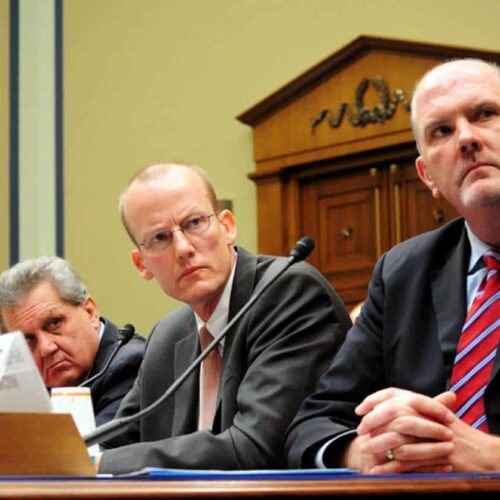Introduction
Republicans sought to move blame for the botched Fast and Furious gun smuggling sting from the Mexican border all the way back up to the White House in a contentious House hearing Tuesday.
While GOP lawmakers were largely unable to get six agents from the Bureau of Alcohol, Tobacco, Firearms and Explosives to name names, the House investigators did manage to produce an email linking the ATF’s troubled Phoenix field division to 1600 Pennsylvania Avenue. William Newell, the former ATF special- agent-in-charge of the Phoenix office who helped concoct the Fast and Furious plan, sent an email to Kevin O’Reilly, a long-time friend of his in the White House, detailing his office’s plans for explaining ATF’s broader border enforcement efforts to the press. O’Reilly was until recently director of North American affairs for the National Security Council.
“You didn’t get these from me…” Newell wrote on the morning of September 3, 2010. He then went on to explain to O’Reilly the two internal media briefing documents he’d attached about the ATF’s border enforcement strategy, known as Gun Runner. By this time the Fast and Furious investigation had already allowed more than a thousand guns to be bought by suspected straw buyers for the Sinoloa Mexican drug cartel.
GOP members of the House Committee on Oversight and Government Reform and a staff report released by the panel tried to tie Fast and Furious not only to the White House and ATF leaders, but also to Justice Department executives. The report said Assistant Attorney General Lanny Breuer was “clearly” aware of Fast and Furious months before it became public. A Justice Department spokeswoman, however, said details of the investigation were unknown to senior Justice officials.
The Center for Public Integrity’s iWatch News wrote extensively about Fast and Furious last spring. Federal prosecutors and the ATF permitted some 2,000 guns to be purchased and retained by suspected straw buyers with the expectation they might cross the border and even be used in crimes while the case was being built. ATF officials were hoping to follow the guns in hopes of making cases against higher-level traffickers. The decision was met by strong objections from some front-line agents who feared they were allowing military-style weapons to “walk” into the hands of drug lords and gun runners, internal agency memos show. Indeed, the staff report released Tuesday said at least 122 of these weapons were recovered in 48 separate incidents in Mexico.
The report was compiled by staff working for Darrell Issa (R-Calif.), chairman of the House panel, and Sen. Charles Grassley (R-Iowa), ranking Republican on the Senate Judiciary Committee.
The hearing also revealed a rift between ATF executives involved in Fast and Furious and the agency’s staffers at the U.S. embassy in Mexico City. Carlos Canino, ATF’s acting attaché to Mexico, said that “as a result of this investigation, the Sinaloa cartel may have received almost as many guns [as] are needed to arm [an entire U.S. Army regiment].” Canino said that “out of these 2,000 weapons, 34 were .50-caliber sniper rifles. That is approximately the number of sniper rifles a Marine infantry regiment takes into battle.”
Civilians in Mexico are not legally allowed to purchase high-caliber weapons. As a result, many of the powerful guns seized in Mexico originate in the U.S. ATF Senior Special Agent Jose Wall told lawmakers that of the 2,000 or so guns he’d seen at Mexican crime scenes, less than 50 had not come through the U.S.
Earlier in the hearing, Democrats on the committee had sought to portray Fast and Furious as a misguided attempt by one ATF office to take down a gun-running ring, despite what they described as a significant lack of resources. As ranking Democrat Rep. Elijah Cummings (D-Md.) pointed out in his opening statement, Acting Deputy Director of ATF William Hoover told investigators in sworn testimony that “[i]t’s my firm belief that the strategic and tactical decisions made in this investigation were born and raised with the U.S. Attorney’s Office and with ATF and [an inter-agency federal task force] in Phoenix.”
“After receiving briefings in March 2010, Deputy Director Hoover and other senior ATF officials became seriously concerned about the number of weapons being trafficked,” and sought to close the case and seek indictments within 90 days, Cummings said. But he could not explain why it took more than nine months for Hoover’s “exit strategy” to be executed, and the hearing did little to shed light on that mystery.
Read more in National Security
National Security
Army did not properly test more than 5 million bullet-proof plates
National Security
Congress urged to put Coast Guard on short leash with budget-busting Deepwater project
Project to buy or modernize ships, planes may already be $5 billion over budget


Join the conversation
Show Comments